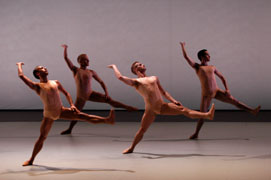
Jack Anderson
Ballet Biarritz
 |
| Ballet Biarritz at the Joyce Theater. Photo by Olivier Houeix. |
Ballet Biarritz
Joyce Theater, 175 Eighth Avenue at 19th Street, Chelsea
June 24-28, 2008
Tuesday and Wednesday at 7:30 p.m., Thursday and Friday at 8 p.m.,
Saturday at 2 and 8 p.m., $34
Tickets: (212) 242-0800 or www.joyce.org
Reviewed June 26, 2008
Ballet Biarritz promised much with two works reflecting France's longstanding fascination with Spain. Good-looking dancers and designs attracted the eye, and the ear was ravished by scores by Maurice Ravel and Manuel de Falla. But these fancy trappings adorned inexpressive choreography by Thierry Malandain, the French company's director, and ideas announced in the program notes were not always actualized on stage.
"Le Portrait de l'infante" was Malandain's staging of a ballet that probably never existed. In 1923, Sonia Pavloff, of the Opéra Comique in Paris, asked Ravel for a ballet on a Spanish theme. Fearing he had no time to write one, he suggested stitching together some of his existing Spanish-influenced music. There is no evidence that Pavloff's ballet was ever produced, and Malandain has done his own version to "Le Gibet," "Pavane pour une infante defunte," "Alborado del gracioso," and "Rapsodie espagnole."
Although a few dramatic vignettes crystallize, the production is essentially a plotless tribute to the style of Velázquez. The stage is dominated by three enormous, and rather ominous, sculptures by the contemporary Spanish artist Manolo Valdés that preserve the essential outline of the era's female court costumes. With their stiff wide headdresses and skirts, these shapes resemble enormous bells.
Dancers gather around them and push them about, shifting their positions. But whereas the results are visually impressive, these actions are surprisingly devoid of emotional strength. Although moments in which dancers hold their hands like paws may symbolize the court's dogs and prancing steps presumably represent royal horses, only one incident has dramatic force, a vignette for two capering men (Frederik Deberdt and Arnaud Mahouy) who suddenly stare at each other with horror, as if facing a mirror. This scene is based on a tale of a dwarf who fancies himself a handsome knight until he sees his grotesque reflection in a mirror. Although one may have to read the program note to realize fully what is going on here, the encounter has genuine power.
Throughout the ballet, Malandain made inordinate use of unison steps. They turned up again and again in ensembles, and even in love scenes. At first, you could think this uniformity was meant to evoke the rigidity of the Spanish court. But unisons also filled "L'Amour sorcier," inspired by a Gypsy story of a young man and woman whose romantic bliss is troubled by the persistent ghost of the woman's former lover. Harmony can be achieved only when the ghost is distracted by the spirit of another woman. Falla's score, which includes that pops concert favorite, the "Ritual Fire Dance," is deservedly popular, and the story, at least in theory, seems quite choreographable.
However, although the ballet has been staged by a remarkable number of eminent choreographers ever since its first production by the flamenco dancer Pastora Imperio in 1915, the work is somehow jinxed, for no version of it has lasted long. Malandain does nothing to break the evil spell.
Indeed, his obsession with unisons even dilutes the ballet's potential power. By making an entire male ensemble represent the hero, while a female ensemble symbolizes the heroine, Malandain minimizes the possibilities for vivid characterization or dramatic interplay between individuals. Yet his mass movements never suggest why the ballet's scenario should prompt a collective struggle. Only a duet for the ghost (Cédric Godefroid) and another spirit (Miyuki Kanei) truly hold the attention, possibly because, given the ballet's passionate plot, two dancers can be a company worth watching, while the whole company becomes too much of a crowd.
Jorge Gallardo, the designer, put "L'Amour sorcier" on a stage strewn with objects that the troupe's press kit calls petals, but which also resemble leaves. Whatever the company may be dancing on, that setting provides them with mystery, a mystery the choreography never deepens.
| museums | NYTW mail | recordings | coupons | publications | classified |
